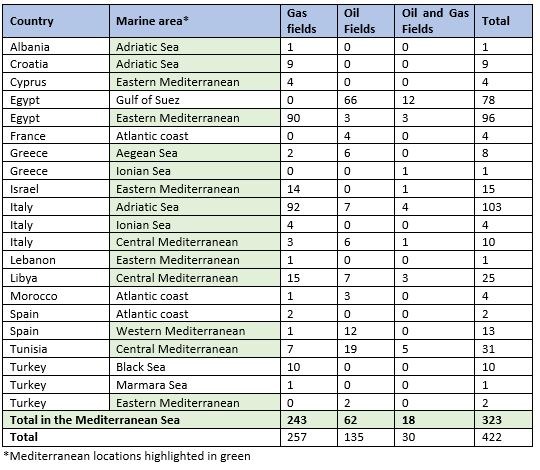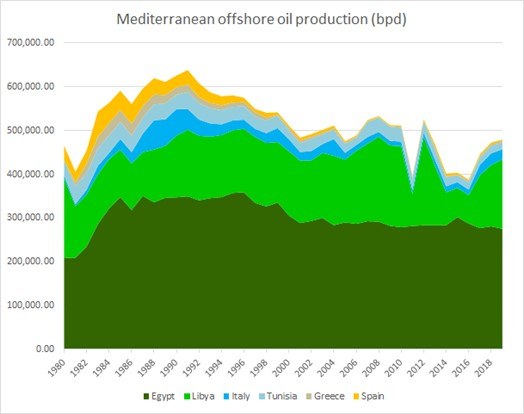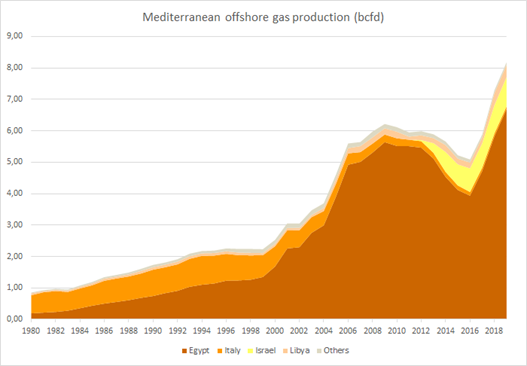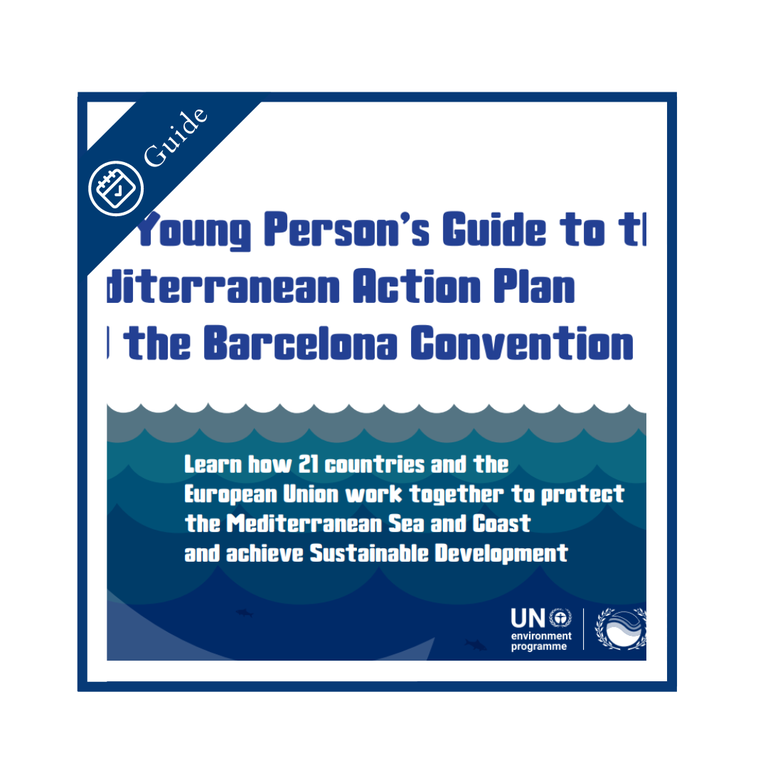Hot Topics
Decommissioning
According to the recent Study on trends and outlook of marine pollution from ships and activities and of maritime traffic and offshore activities in the Mediterranean prepared by REMPEC in collaboration with UNEP/MAP secretariat, MEDPOL, SPA/RAC and Plan Bleu, a total of 323 oil and gas fields are found in the Mediterranean Sea. Oil and gas production currently takes place in four major areas: (i) the Southern Levantine Sea where Egyptian and Israeli offshore production occurs (mainly gas), (ii) the Channel of Sicily (Italian and Tunisian activities), (iii) the Gulf of Gabes (Tunisia) and the neighbouring Libyan marine area, and (iv) the northern Adriatic, where most of the Italian offshore gas activities are concentrated and where Croatian gas production is located.
Table: Number of oil and gas offshore fields for each Mediterranean country 
Note that some of the countries’ own fields which are located outside the Mediterranean; related numbers are provided for completeness of the information. The total number of Mediterranean fields considers those located within the basin.
Data source: Clarksons Research Offshore Intelligent Network, data retrieved on 08.06.2020. Figures retrieved from EP/MED WG.498/Inf.4.
Oil production is characterized by a decreasing trend in the Mediterranean (including marked variability after 2001, as compared to the substantially stable global trend since 2001). On the other hand, Mediterranean Sea plays a more significant role in gas production at the global level, with the trend in offshore gas production showing a clear and marked increase since the 1980s. Egypt is the main offshore gas producer in the Mediterranean, historically followed by Italy. In recent years, the Italian production of offshore natural gas decreased significantly, while the production of Israel has greatly increased, in particular owing to the discovery of, and production in the rich Leviathan gas field. In the coming years, other Eastern Mediterranean countries are expected to enter the offshore gas market as producer.

 Figure: Top: Trend of offshore oil production in the Mediterranean Sea (bpd = barrels per day), Data retrieved on 29.06.2020;
Figure: Top: Trend of offshore oil production in the Mediterranean Sea (bpd = barrels per day), Data retrieved on 29.06.2020;
Bottom: Trend of offshore gas production in the Mediterranean Sea (bcfd = billion cubic feet per day), Data source: Clarksons Research Offshore Intelligent Network (Data retrieved on 04.06.2020).
Compared to other regions, the Mediterranean Sea is a small producer of offshore oil and gas. While offshore gas explorations have expanded in recent years, there have been no major discoveries of offshore oil fields after 2010. As an important number of old offshore platforms are approaching the end of operational lifetime, their decommissioning is a challenge to be addressed in the near future. Offshore oil production is projected to slightly decrease in the Mediterranean, while offshore gas extraction is expected to significantly increase, due to the expansion of the sector in the Levantine basin, involving also deep and ultradeep waters (link to regional study).
Decommissioning of offshore platforms is currently a highly relevant topic, not just for the Mediterranean but also in other regions. It is proposed as a priority topic for the next biennium 2022-2023. The technical evaluation of the removal methods, as well as their sustainability implications, environmentally sound management and optimal treatment should be discussed. The Barcelona Convention Offshore Oil and Gas Group (OFOG) Sub-Group on Environmental Impact presents an excellent regional platform for this discussion.
Offshore Monitoring
Specific Objective 9. of the Mediterranean Offshore Action Plan (Decision IG.22/3) calls for the establishment of a regional Offshore Monitoring Programme under the framework of Integrated Monitoring and Assessment Programme (IMAP) of the Barcelona Convention. The expected actions/outputs and key milestones include:
- a) A regional monitoring programme for offshore activities building through a set of indicators to complement IMAP addressing offshore activities is developed and adopted
- b) National offshore monitoring programs established, and reporting as part of IMAP implementation
Article 19 Monitoring of the Offshore Protocol builds on the relevant work undertaken in the Monitoring Correspondence Groups on the Ecosystem Approach (EcAp) process in line with Decision 21/3. IMAP monitoring data will be used to compliment the more targeted and site-specific monitoring of offshore installations and activities, and to provide information on whether the impact of offshore activities affects the wider marine and coastal environment. It will also contribute towards the development of the Mediterranean Offshore Reporting and Monitoring System, i.e. regional data bank on offshore activities through the Barcelona Convention Reporting System (BCRS) or other systems defined by the Contracting Parties, with the support of Info/RAC. One component of the regional system will allow for the regular reporting of data on discharges and emissions from offshore oil and gas installations, which will be used for the production, dissemination and publication of a regional report on Discharges, Spills and Emissions on a biennial basis.
IMAP Quality Indicators
A set of 19 IMAP quality indicators relevant to the Offshore Monitoring Programme was presented at 1st Meeting of the Barcelona Convention Offshore Oil and Gas Group (OFOG) Sub-Group on Environmental Impact in 2017, together with methodological guidance for monitoring (UNEP(DEPI)/MED WG.434/4), minimum requirements for the establishment of a National Offshore Monitoring Inspection Programme (UNEP(DEPI)/MED WG.434/5) and related draft guidance fact sheets (UNEP(DEPI)/MED WG.434/6). This list was later consolidated to 8 IMAP quality indictors directly relevant to the potential impact and effects of oil and gas operations (REMPEC/WG.45/INF/16). These are:
- Common Indicator 1: Habitat distributional range, to also consider habitat extent as a relevant attribute (EO1);
- Common Indicator 2: Condition of the habitat’s typical species and communities(EO1);
- Common Indicator 15: Location and extent of the habitats impacted directly by hydrographic alterations (EO7);
- Common Indicator 17: Concentration of key harmful contaminants measured in the relevant matrix (EO9, related to biota, sediment, seawater);
- Common Indicator 18: Level of pollution effects of key contaminants where a cause and effect relationship has been established (EO9);
- Common Indicator 19: Occurrence, origin (where possible), and extent of acute pollution events(e.g. slicks from oil, oil products and hazardous substances) and their impact on biota affected by this pollution (EO9);
- Candidate Indicator 26: Proportion of days and geographical distribution where loud, low, and mid-frequency impulsive sounds exceed levels that are likely to entail significant impact on marine animals (EO11);
- Candidate Indicator 27: Levels of continuous low frequency sounds with the use of models as appropriate (EO11).
Common Indicators 1, 2, 15, 17 and 18 (marked in bold) are the key monitoring indicators for the oil and gas industry, and it is proposed that the main monitoring effort will focus on these five indicators.
The Young Person’s Guide to the Mediterranean Action Plan and the Barcelona Convention
The Mediterranean Action Plan of the UN Environment Programme (UNEP/MAP) has released the “Young Person’s Guide to the Mediterranean Action Plan and the Barcelona Convention” aimed at ocean literacy practitioners, educators and young readers aged 11-17.
Read the article dedicated to this topic on UNEP/MAP website
- Download the guide available below :


